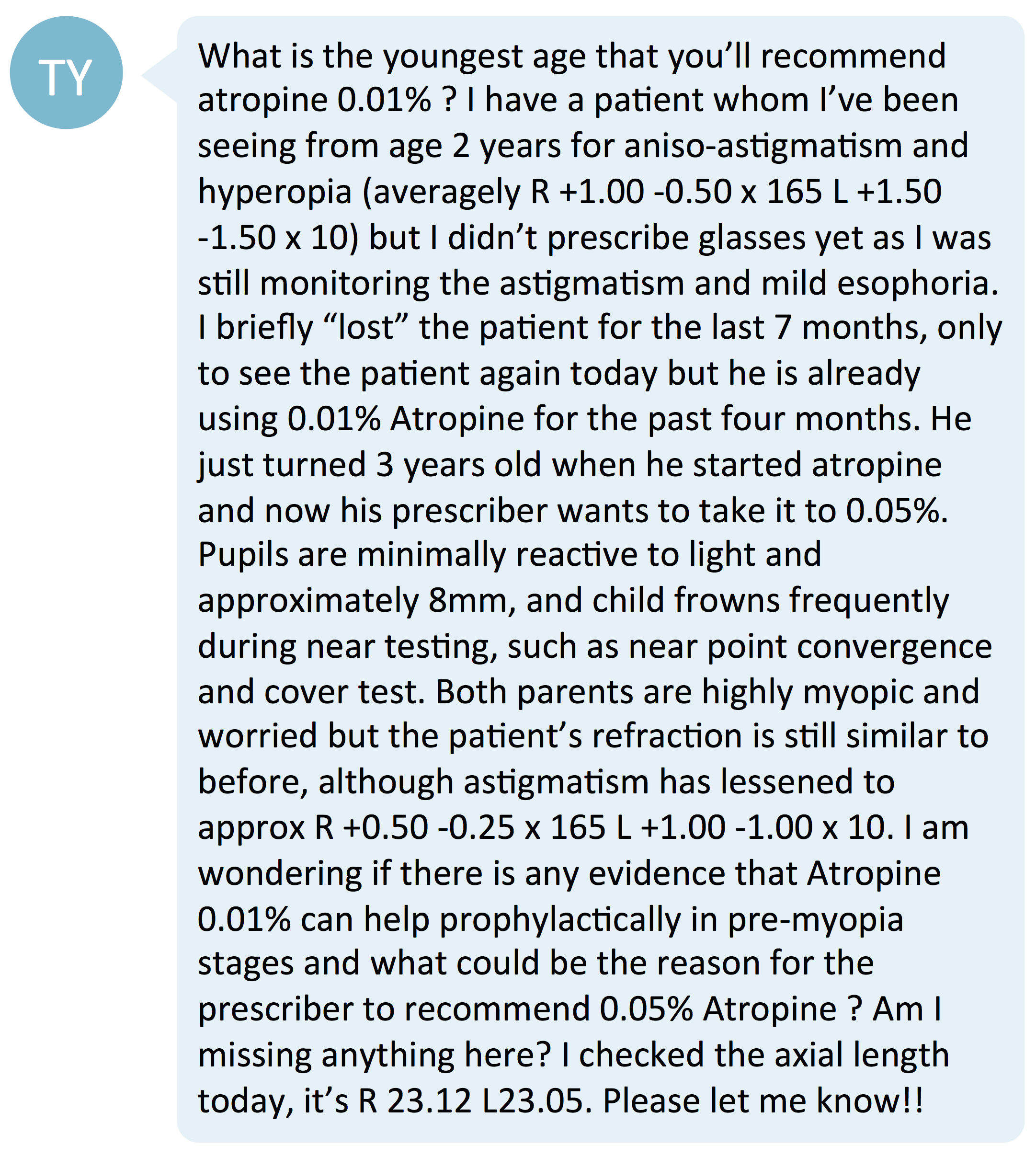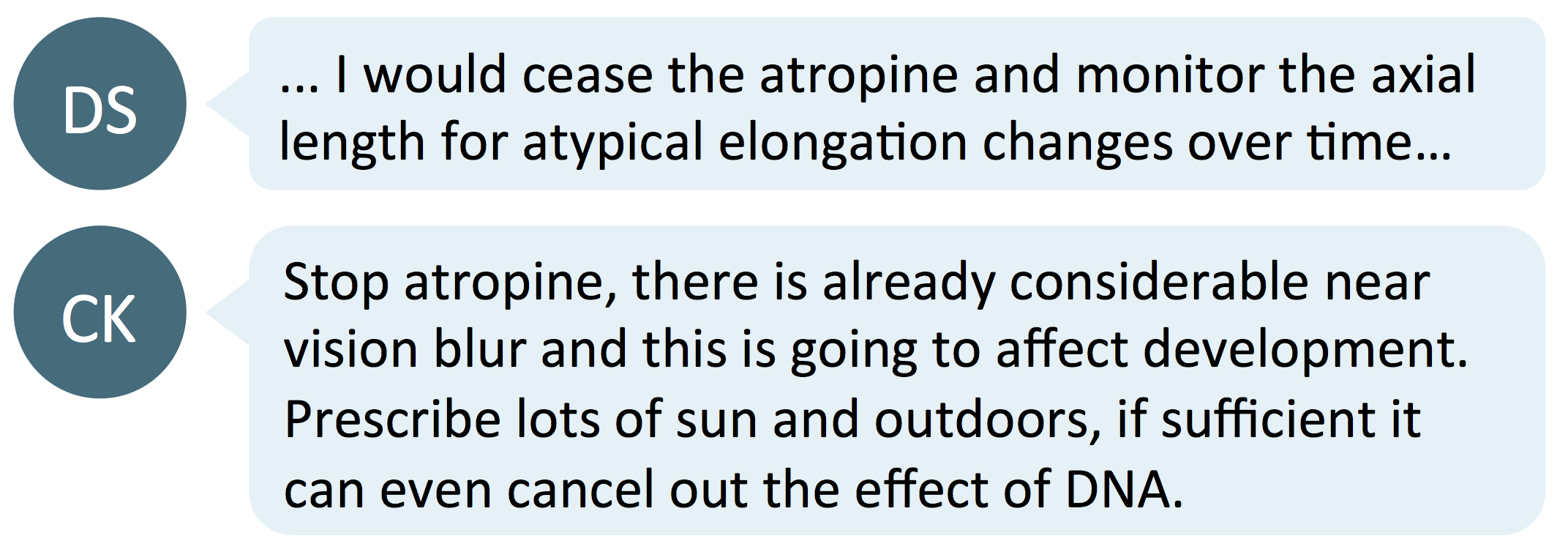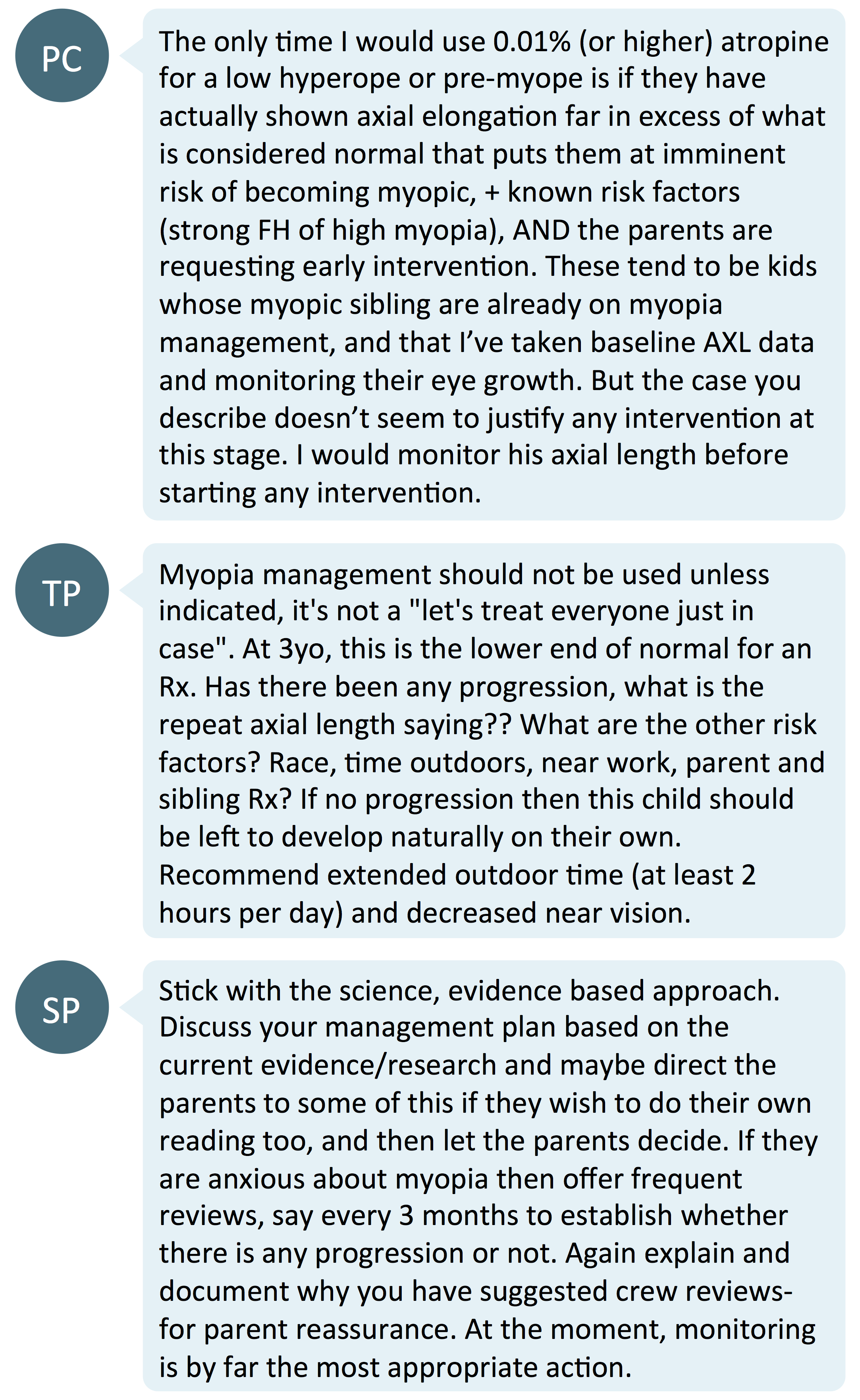What level of intervention is ideal for a pre-myopic child? What is the youngest age suitable for atropine treatment? This case involves a 3-year-old hyperopic and astigmatic child who has been prescribed low-concentration atropine to delay myopia onset by an eye care practitioner other than the one posting this case.

Is low-concentration atropine treatment necessary in this case? If it is, which concentration is suitable? The discussion of the Myopia Profile Facebook community is detailed below.
Is the child’s axial length and refractive error normal?

In a meta-analysis of ocular of axial length in newborns and infants, the mean axial length of 3-year-old children is 21.8mm.1 In this analysis, the authors also found that males have longer axial length than females at birth.1 TY’s patient has longer axial eye length when compared to the average.
In addition, his spherical equivalent is slightly more minus than the average 3-year-old child, which is +1.00D.2 At this age, the emmetropization process is active, which will likely see this child lose their small amount of hyperopia and progress into myopia.
Is topical atropine necessary?

Many commenters suggested to stop atropine treatment due to lack of information on the rate of refractive change and/or the rate of axial elongation. There was also concern raised about the side effects of treatment, with the child exhibiting very large pupils and apparent near vision difficulties. Instead, the more conservative approach was suggested - to advise the parents on sufficient outdoor time and managing near vision time to delay the onset of myopia.
The efficacy of low-concentration atropine in delaying myopia onset still requires research. One retrospective study, published in 2010, showed that 0.025% atropine may delay myopia onset on pre-myopic school children. These children were aged 6 to 12 years with a spherical equivalent refraction of less than +1.00D. Tolerance was good and the 0.025% atropine group progressed 0.14D in a year compared to -0.58D/year in the control group (no treatment, no placebo). Over one year, 54% of the control group progressed past -1.00D while only 21% did in the treatment group.3
The ATOM3 study is currently underway in Singapore, investigating the efficacy of 0.01% atropine in "preventing the onset and progression of myopia in high risk children with pre-myopia or low-myopia." This placebo controlled, randomized clinical trial has enrolled children aged 5 to 9 years with at least one myopic parent and a spherical equivalent refraction between +1.00 and -1.50. No preliminary data has yet been reported, but data completion is estimated to range between mid-2021 and mid-2023.
Is this child a pre-myope?
The International Myopia Institute defines a pre-myope as "a refractive state of an eye of ≤ 0.75 D and > 0.50 D in children where a combination of baseline refraction, age, and other quantifiable risk factors provide a sufficient likelihood of the future development of myopia to merit preventative interventions."4
The IMI paper does not define a lower age for pre-myopia, but notes that the CLEERE study, which involved children aged 6-13 years, showed that a refraction close to emmetropia was the best single predictor of future myopia. The cut offs for predicting myopia by age 13 were < +0.75 D at age 6, ≤ +0.50 D at ages 7 to 8, ≤ +0.25 D at ages 9 to 10, and ≤ 0 D at age 11 years.5
There simply isn't any data on refraction at age 3 and future risk of myopia, but given that this child's low level of hyperopia would raise concern at age 6 or 7, and their family history of high myopia, it is a reasonable conclusion.
How proactively should we manage this child, given their clear myopia risk but young age and lack of evidence-base for suitable treatment? Ultimately this comes down to considering the benefits versus the side effects; and collaborative communication with the parents to determine their goals and understanding of treatment, to gain informed consent.
How would you manage this child?

The commenters supported a careful approach to managing this young child, leaning towards providing advice on visual environment and more frequent monitoring rather than prescribing topical atropine for preventative myopia treatment.
If or when this child becomes myopic, the youngest age for which there is currently evidence is 4 years of age - the inclusion criteria for the Low-Concentration Atropine and Myopia Progression (LAMP) Study.6
Two current, multi-site clinical trials on commercially prepared atropine formulations are currently enrolling children down to 3 years of age: the CHAMP Study investigating a preservative-free, single use formulation and the STAAR Study investigating "proprietary technology... designed for maximum stability and tolerability."7 Three year data is expected for the CHAMP Study in 2022, while the STAAR Study lists estimated primary completion as mid-2024.
Take home messages:
- There is currently only a small amount of evidence for prescribing 0.025% atropine in pre-myopia and research underway in the use of 0.01%. Until publication of the latter, the best evidence-based treatment to delay myopia onset is increasing time spent outdoors.8 Some practitioners may choose to prescribe topical atropine for myopia prevention, though, after considering the myopia risk factors, balance of benefits to side effects, and parental understanding and goals for treatment.
- Obtaining informed consent for any myopia control treatment is important, but especially so for treatments which fall outside of the current range of evidence. In this case, prescribing for very young children requires parents to understand that efficacy cannot be assured and side effects could vary where there is a lack of research evidence. For myopic children, there will soon be evidence for atropine treatment down to 3 years of age as data from current clinical trials is revealed.
Read more on topical atropine and on pre-myopia
Check out these clinical cases

About Connie
Connie Gan is a clinical optometrist from Kedah, Malaysia, who provides comprehensive vision care for children and runs the myopia management service in her clinical practice.

About Kimberley
Kimberley Ngu is a clinical optometrist from Perth, Australia, with experience in patient education programs, having practiced in both Australia and Singapore.
This content is brought to you thanks to an unrestricted educational grant from

References
- Groot AL, Lissenberg-Witte BI, van Rijn LJ, Hartong DT. Meta-analysis of ocular axial length in newborns and infants up to three years of age. Survey of Ophthalmology. 2021 Jun 9. (link)
- Mayer DL, Hansen RM, Moore BD, Kim S, Fulton AB. Cycloplegic refractions in healthy children aged 1 through 48 months. Archives of ophthalmology. 2001 Nov 1;119(11):1625-8. (link)
- Fang PC, Chung MY, Yu HJ & Wu PC. Prevention of myopia onset with 0.025% atropine in premyopic children . J Ocular Pharm Ther 2010;26:341-345. (link)
- Flitcroft DI, He M, Jonas JB et al. IMI - Defining and Classifying Myopia: A Proposed Set of Standards for Clinical and Epidemiologic Studies. Invest Ophthalmol Vis Sci. 2019;60:M20-M30. (link)
- Zadnik K, Sinnott LT, Cotter SA, et al. Prediction of juvenile-onset myopia. JAMA Ophthalmol. 2015; 133: 683–689. (link)
- Yam JC, Jiang Y, Tang SM, Law AK, Chan JJ, Wong E, Ko ST, Young AL, Tham CC, Chen LJ, Pang CP. Low-concentration atropine for myopia progression (LAMP) study: a randomized, double-blinded, placebo-controlled trial of 0.05%, 0.025%, and 0.01% atropine eye drops in myopia control. Ophthalmology. 2019 Jan 1;126(1):113-24. (link)
- https://eyewire.news/articles/sydnexis-announces-enrollment-of-first-patients-in-phase-3-myopia-staar-study-of-syd-101-in-children/ Accessed February 21, 2022.
- Jonas JB, Ang M, Cho P, Guggenheim JA, He MG, Jong M, Logan NS, Liu M, Morgan I, Ohno-Matsui K, Pärssinen O, Resnikoff S, Sankaridurg P, Saw SM, Smith EL 3rd, Tan DTH, Walline JJ, Wildsoet CF, Wu PC, Zhu X, Wolffsohn JS. IMI Prevention of Myopia and Its Progression. Invest Ophthalmol Vis Sci. 2021 Apr 28;62(5):6. (link)










